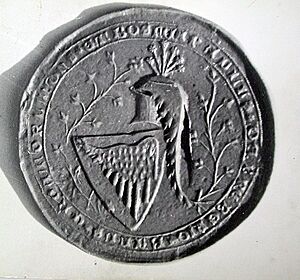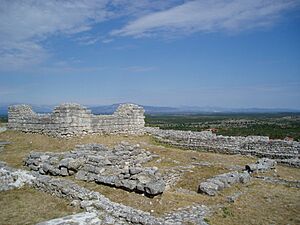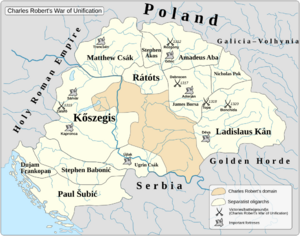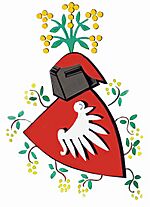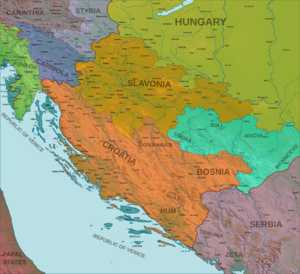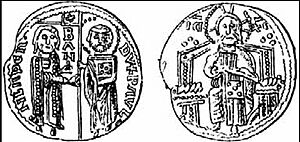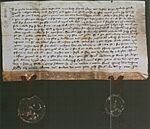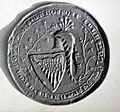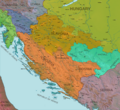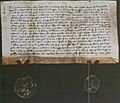Paul I Šubić of Bribir facts for kids
Quick facts for kids Paul I Šubić of Bribir |
|
|---|---|
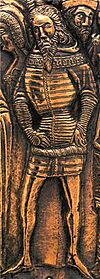
Depiction of Paul Šubić from the 14th century Chest of Saint Simeon
|
|
| Ban of Croatia | |
| Reign |
|
| Predecessor |
|
| Successor | Mladen II Šubić |
| Lord of Bosnia | |
| Reign | 1299–1312 |
| Predecessor | Stephen I Kotromanić |
| Successor | Mladen II Šubić |
| Born | c. 1245 |
| Died | 1 May 1312 (aged 66–67) |
| Burial | Church of St. Mary, Bribir, Kingdom of Croatia |
| Spouse |
Ursa
(m. 1289; died 1303) |
| Issue |
|
| House | Šubić |
| Father | Stephen II Šubić |
| Religion | Roman Catholic |
Paul I Šubić of Bribir (Croatian: Pavao I. Šubić Bribirski; c. 1245 – 1 May 1312) was a very powerful Croatian noble. He was the Ban of Croatia from 1275 to 1312. He also became the Lord of Bosnia from 1299 to 1312.
Paul was the oldest son of Stephen II from the important Šubić family. He took over as the count of Bribir. He first became a ban in 1273. He lost the job briefly in 1274 because of fights between the cities of Trogir and Split. But he got it back in 1275.
With his brothers, Mladen I and George I, Paul took control of most coastal cities. He also fought against the Kačić family, who were pirates in the Adriatic Sea. This led to conflicts with the Republic of Venice. At the same time, the Šubićs became friends with the House of Anjou from Naples.
During a time when there was no clear king in the 1290s, Paul became one of the strongest leaders. He supported the Anjou family in their fight for the throne. In 1300, Paul invited Charles Robert of Anjou to Split. He then went with him to Zagreb, where Charles was recognized as king of Hungary and Croatia.
Paul made his own lands much bigger. He took over the Banate of Bosnia in 1299 and Hum in 1301. He gave these lands to his family members to rule. In 1304, Paul led a military trip into Bosnia after Mladen I, who was Ban of Bosnia, was killed. Paul quickly stopped the rebellion. He then made his son, Mladen II, the new Ban of Bosnia.
Paul was so powerful that the king's authority over his lands was very weak. Paul managed to make his titles hereditary for his family. His main homes were in Bribir and the city of Skradin. He even made his own coins using silver from Bosnia. He also helped create three new Catholic dioceses in Croatia. In 1311, Paul helped a rebellion against Venice in Zadar. He gained control of the city, which started another war with Venice. Paul died in May 1312, soon after taking Zadar. His oldest son, Mladen II, took over from him.
Contents
Paul's Early Life
Paul was the oldest son of Stephen II. The Šubić family was the most important noble family in Croatia and Dalmatia. At that time, Croatia was joined with the Kingdom of Hungary. Paul was born around 1245. He had two brothers, Mladen I and George I. He also had a sister named Stanislava.
Paul's father, Stephen II, was involved in a war with the Mongol Empire in 1242. King Béla IV found safety in Trogir, which Stephen governed. For his help, King Béla gave the County of Bribir to Stephen and his family forever in 1251. Around this time, Stephen became the head of the Šubić family. Besides Trogir and Bribir, the Šubićs also ruled the County of Šibenik.
Paul became the count of Bribir after his father died before 1267. We first hear about Paul in 1272. He was the mayor (Podestà) of Trogir. In May 1273, Paul was the Count of Trogir and Split. His brother, George I, was named Count of Šibenik. Paul was also the ban of the coastal regions. This role was also called Ban of Croatia. Through this job, Paul and his brothers quickly became very powerful.
Paul's Rule and Power
Taking Control of Lands
Paul got involved in a long-standing fight between Split and Trogir. These two cities had been at war. Paul supported Split and tried to take more control over Trogir. He ignored warnings from King Ladislaus IV, who protected Trogir. In 1274, Paul managed to take control of Trogir.
He also helped Šibenik in a dispute with Trogir over the Church. Paul wanted the Church in Šibenik to be separate from Trogir's control. He was briefly removed from his ban position in 1274 but returned in 1275. After this, Paul became the only ban in Croatia.
Paul's brother, Mladen I, became the mayor of Trogir. By 1278, the Šubić family controlled almost all coastal cities south of the Velebit Mountain. This included Skradin near Šibenik. Skradin was one of Paul's main homes, along with Bribir, Klis, and the Ostrovica Fortress. Paul also owned the castles of Knin and Počitelj.
Paul wanted to control the lands of the Kačić family. They were pirates based in Omiš. The House of Anjou from Naples also wanted to stop these pirates. During this time, the Šubić and Anjou families became friends. The Angevins controlled southern Italy, which was important for getting food to Dalmatian cities.
The Angevins took the islands of Hvar and Brač from the Kačićs in 1275. The Republic of Venice also started fighting the Kačićs in 1276. By 1278, Hvar and Brač were under Venetian rule. This worried Paul, so he joined the fight against Venice. Paul gained control of Omiš and the island of Brač. His brother, George I, became Count of Omiš. The Kačićs lost their power, which stopped the pirate threat to Paul's ships.
In 1288, Paul started talking about peace with Venice. A peace treaty was signed in May 1290. Paul promised that pirates from Omiš would not attack Venetian ships. The cities of Trogir, Šibenik, and Split agreed to pay money to Venice as a guarantee. Venice promised not to attack Paul's lands. This peace treaty was broken in 1293 when Venice took Omiš. The fighting continued until 1294, when a new peace treaty was signed. Omiš was returned to the Šubićs.
Paul had good relations with the Pope and the Catholic Church. They both wanted to stop heresy and reduce Venice's power in the Adriatic. They also supported the House of Anjou for the throne.
The Fight for the Throne
When King Ladislaus IV died in 1290 without children, a fight for the throne began. It was between Andrew III of the Árpád family and Charles Martel of the House of Anjou. Most Croatian nobles, including the Šubićs, supported Charles Martel. Andrew III found an ally in Stephen III Babonić. This led to a dispute between the Šubićs and the Babonićs over some land.
In 1292, Charles Martel's father, Charles II, gave Paul and the Šubić family the right to rule all of Croatia. This meant they would rule from the Gvozd Mountain to the Neretva River. In 1293, Andrew III also named Paul the hereditary ban of Croatia and Dalmatia. For a short time, Paul might have supported Andrew. But Paul soon turned back to the Angevins.
Charles Martel died suddenly in 1295. His rights to the throne went to his son, Charles Robert. Charles II confirmed Paul's position as ban for life. In 1299, Charles II confirmed all of Paul's lands, both current and future. This was on the condition that the Šubićs would provide soldiers for the Angevins.
Paul believed that the Pope should decide who was king of Hungary and Croatia. He sent George I to visit the Pope in Rome in 1300. George convinced Charles II to send his grandson, Charles Robert, to Split. Paul would meet him there. George also got the Pope's approval to make the Church in Šibenik separate from Trogir.
George and Charles Robert arrived in Split in August. From there, Paul went with Charles to Zagreb. There, loyal nobles recognized Charles as king.
Andrew III died in January 1301. Around this time, Paul was on a trip to Rome. Charles quickly went to Esztergom and was crowned king. Paul did not get involved in Charles Robert's activities in Hungary. He focused on expanding his own lands. Charles was not fully recognized as king for another 10 years. Paul rarely mentioned the king in his documents. He was almost an independent ruler.
Growing Paul's Power
In 1299, Paul expanded his rule to the Banate of Bosnia. He took the title of lord of Bosnia. Paul's main ally in Bosnia was Hrvatin Stjepanić. Paul's rule was challenged by Stephen I Kotromanić. In 1302, Mladen I marched against Stephen. By May, he controlled most of Bosnia. Mladen I became the new Ban of Bosnia.
Paul also expanded to the southeast in 1301. He took advantage of a civil war in Serbia. He captured the entire region of Hum. He then attacked the city of Kotor. Paul's oldest son, Mladen II, was named Lord of Hum.
His brother Mladen I died in June 1304. Paul then led an army into Bosnia to show his power again. He re-established his rule by February 1305. He gave the title of ban to Mladen II. Paul took the title of lord of all Bosnia. Charles Robert gave Paul the right to pass the Banate of Bosnia to his family in 1308.
Paul's Final Years
Paul liked to be called "ban of the Croats." This showed that his power came from the Croatian people and nobles, not from a higher king. This way, he showed he was independent. Paul's family symbol was an eagle's wing on a shield. He had offices in Skradin and Bribir. He made his own coins using silver from Bosnia. These coins had the names of Mladen I and Mladen II, the bans of Bosnia, and Paul's name.
Paul also helped create two new church areas (dioceses). One was in Duvno, and the other in Omiš. In Skradin, which became Paul's main home, the church of St. John the Baptist was built. Paul chose this saint as his family's protector. A Franciscan monastery was also built in Skradin. In Bribir, the Franciscan church of St. Mary was built. This church was used for burying the Šubić family.
The Šubićs wanted to connect their rule to earlier Croatian dukes and kings. They especially looked to King Demetrius Zvonimir. He ruled Croatia in the late 1000s. A story from the early 1300s says Zvonimir was buried in the same church as the Šubićs. In 1302, Paul wrote to the Pope that Croatia had been under the Pope's authority since King Zvonimir's time.
At the height of his power, Paul wanted to control the city of Zadar. It was the only coastal city not under his rule. He had strong connections with Zadar's nobles. In 1308, Venice captured the city of Ferrara in Italy. The Pope said Ferrara belonged to the Papal States. So, the Pope put a ban on Venice.
In 1310, there was an attempt to overthrow the leader of Venice. The person who tried, Bajamonte Tiepolo, found safety in Paul's lands. Paul gathered an army near Zadar in 1310. An uprising against Venice broke out in Zadar in March 1311. Paul's son, Mladen II, led the army to help the rebels. The Venetians had to leave the city. Mladen II was named Count of Zadar.
Mladen's forces successfully fought off the attacks. Both the Pope and King Charles Robert protested Venice's attacks on Zadar. Venice agreed to peace talks in April 1312. Fighting continued, and the Venetian fleet commander was captured. Paul's second son, George II, handled the talks.
Paul died on May 1, 1312. He was buried in the church of St. Mary in Bribir. His son, Mladen II, became the new leader.
Paul's Family
We don't know the name of Paul's first wife. Paul married his second wife, Ursa, in 1289. She might have been the sister of Hrvatin Stjepanić. Ursa died in 1303. A story about her death called her the "baness of the Croats."
Paul's two brothers, Mladen I and George I, were very important during his rule. Paul had four sons. He gave them important jobs and lands. His first son was Mladen II. He was the Prince of Dalmatia, Count of Zadar, and Ban of Bosnia. He took over from his father as Ban of Croatia and Lord of Bosnia. Mladen was married to Helen, who was related to the House of Anjou.
After his father died, Mladen kept the titles of Ban of Bosnia and Lord of Hum for himself. He let his brother George II, Paul's second son, help with the government. George II was the count of Dalmatian cities. Paul's other two sons, Paul II and Gregory II, were much younger. They held less important titles.
Images for kids


